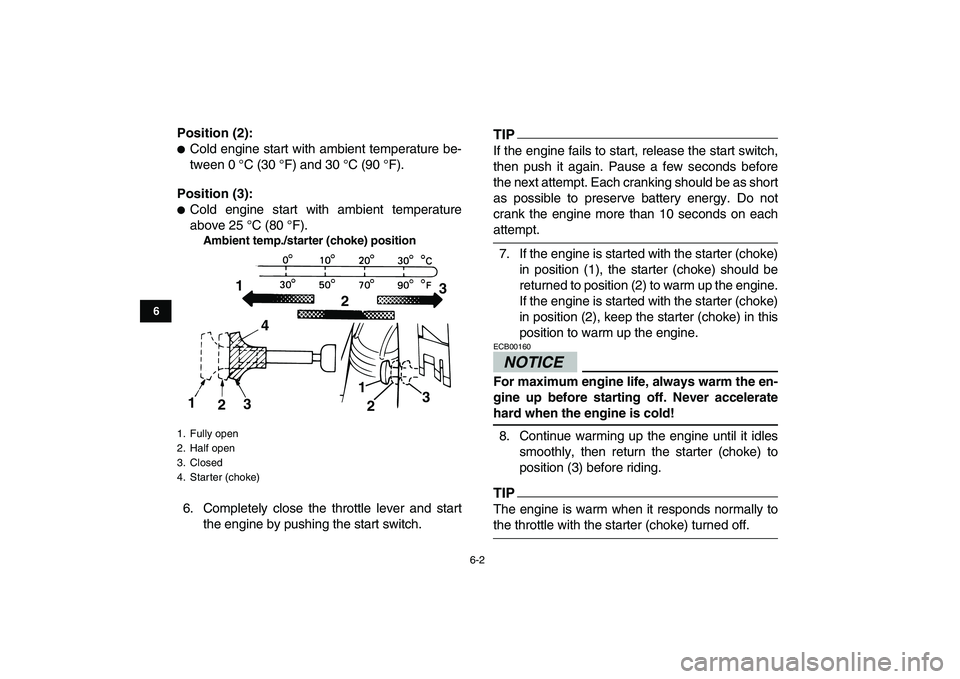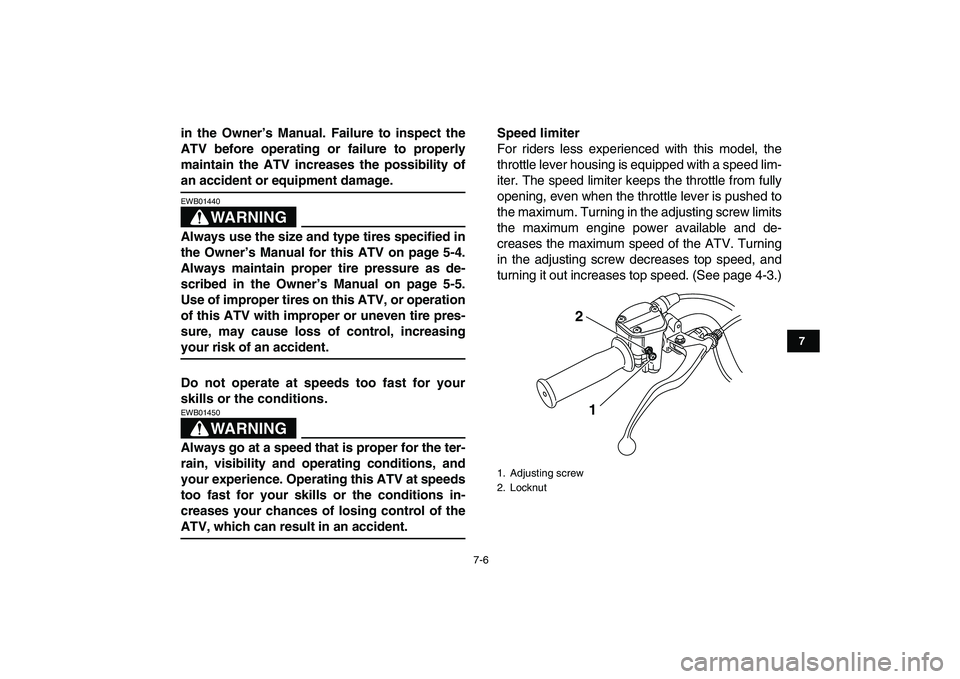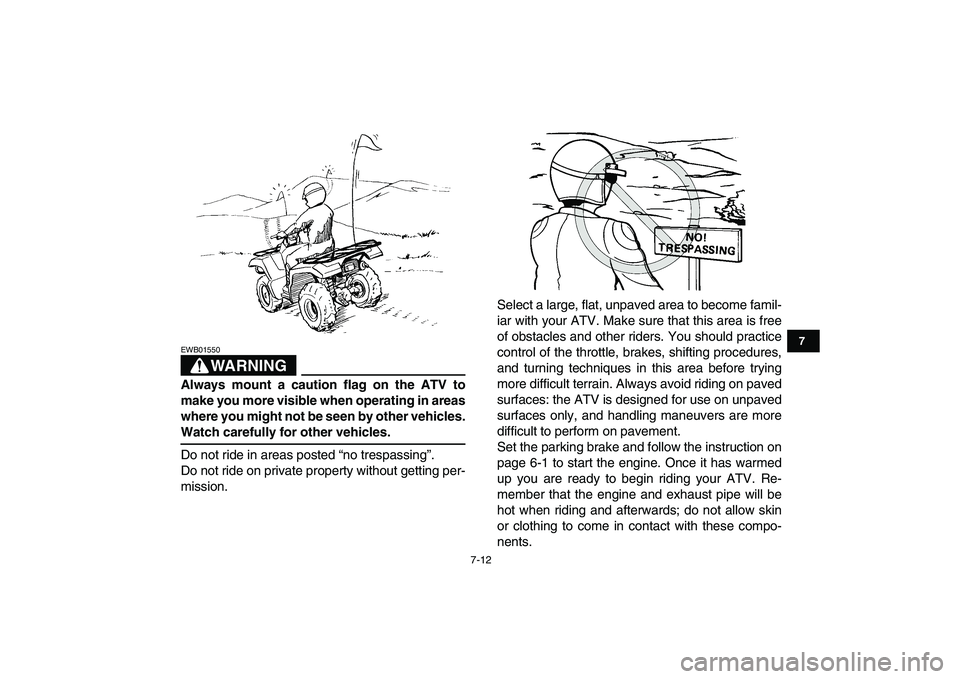Page 40 of 130

6-2
1
2
3
4
56
7
8
9
10
11
Position (2):
�
Cold engine start with ambient temperature be-
tween 0 °C (30 °F) and 30 °C (90 °F).
Position (3):
�
Cold engine start with ambient temperature
above 25 °C (80 °F).
Ambient temp./starter (choke) position
6. Completely close the throttle lever and start
the engine by pushing the start switch.TIP
If the engine fails to start, release the start switch,
then push it again. Pause a few seconds before
the next attempt. Each cranking should be as short
as possible to preserve battery energy. Do not
crank the engine more than 10 seconds on each
attempt.
7. If the engine is started with the starter (choke)
in position (1), the starter (choke) should be
returned to position (2) to warm up the engine.
If the engine is started with the starter (choke)
in position (2), keep the starter (choke) in this
position to warm up the engine.NOTICE
ECB00160
For maximum engine life, always warm the en-
gine up before starting off. Never accelerate
hard when the engine is cold!
8. Continue warming up the engine until it idles
smoothly, then return the starter (choke) to
position (3) before riding.
TIP
The engine is warm when it responds normally to
the throttle with the starter (choke) turned off.
1. Fully open
2. Half open
3. Closed
4. Starter (choke)
1
23
4
1
231
23
Page 41 of 130

6-3
1
2
3
4
56
7
8
9
10
11
EBU20291
Starting a warm engine
Follow the same procedure as for starting a cold
engine, with the exception that the starter (choke)
is not required when the engine is warm. Instead,
start the engine with the throttle slightly open.
EBU20360
Operating the drive select lever and
driving in reverse
NOTICE
ECB00170
Before shifting, stop the ATV, otherwise the
transmission may be damaged.
Shifting: Forward
1. Bring the ATV to a complete stop.
2. Shift from neutral to forward and vice versa by
moving the drive select lever along the shift
guide.
TIP
Make sure that the drive select lever is completely
shifted into position.3. Open the throttle lever gradually.
Shifting: Reverse
1. Bring the ATV to a complete stop.
2. Apply the parking brake.
3. Shift from neutral to reverse and vice versa by
moving the drive select lever along the shift
guide.
TIP
When in reverse, the reverse indicator light should
1. Neutral “N”
2. Forward “F”
3. Reverse “R”
4. Drive select lever
1
2
3
4
Page 42 of 130

6-4
1
2
3
4
56
7
8
9
10
11
come on. If the indicator light does not come on,
have a Yamaha dealer check the electrical circuit.
4. Check behind for people or obstacles, and
then release the parking brake.
5. Open the throttle lever gradually and continue
to watch to the rear while backing.
TIP
If the drive select lever is shifted into reverse while
the engine is running, the engine will stop unless
the rear brake lever or parking brake is applied.
WARNING
EWB00720
Improper operation in reverse could make you
hit an obstacle or even a person behind you,
resulting in serious injury. When you shift into
reverse, make sure there are no people or ob-
stacles behind you. When it is safe to proceed,
go slowly.
EBU20682
Engine break-in
TIP
�
For ATVs equipped with an odometer or an hour
meter, follow the figures given in km (mi) or thefigures given in hours.
�
For ATVs not equipped with an odometer or
hour meter, follow the figures given in hours.
There is never a more important period in the life of
your engine than the first 320 km (200 mi) or 20
hours of riding. For this reason, you should read
the following material carefully.
Since the engine is brand new, do not put an ex-
cessive load on it for the first 320 km (200 mi) or 20
hours. The various parts in the engine wear and
polish themselves to the correct operating clear-
ances. During this period, prolonged full-throttle
operation or any condition that might result in en-
gine overheating must be avoided.
0–160 km (0–100 mi) or 0–10 hours
Avoid prolonged operation above 1/2 throttle. Vary
the speed of the ATV regularly. Do not operate it at
one set throttle position.
160–320 km (100–200 mi) or 10–20 hours
Avoid prolonged operation above 3/4 throttle. Rev
the engine freely, but do not use full throttle at any
time.
Page 43 of 130

6-5
1
2
3
4
56
7
8
9
10
11
320 km (200 mi) or 20 hours and beyond
The ATV can now be operated normally.
NOTICE
ECB00220
If any engine trouble should occur during the
engine break-in period, immediately have a
Yamaha dealer check the ATV.
EBU20700
Parking
When parking the ATV, stop the engine, shift the
drive select lever into the forward position, apply
the parking brake, and then turn the fuel cock to
“OFF”.
EBU20740
Parking on a slope
WARNING
EWB00830
Avoid parking on hills or other inclines. Park-
ing on a hill or other incline could cause the
ATV to roll out of control, increasing the
chance of an accident. If you must park on an
incline, place the ATV transversely across the
incline, shift the drive select lever to the for-
ward position, stop the engine, apply the park-
ing brake, and then block the front and rear
wheels with rocks or other objects.
Do not park the ATV at all on hills that are so
steep you could not walk up them easily.
1. Bring the ATV to a stop by applying the brakes
in the forward position.
2. Stop the engine.
3. With the rear brake applied, apply the parking
brake.
1. Locked position
1
Page 48 of 130
7-3
1
2
3
4
5
67
8
9
10
11
Not recommended for children under 16 years
of age.
WARNING
EWB01390
A child under 16 should never operate an ATV
with engine size greater than 90 cc. Use by chil-
dren of ATVs that are not recommended for
their age can lead to severe injury or death of
the child.
This ATV is designed to carry operator and
cargo only – passengers prohibited.
WARNING
EWB01400
Never carry a passenger. The long seat is to al-
low the operator to shift position as neededduring operation. It is not for carrying passen-
gers. Carrying a passenger on this ATV greatly
reduces your ability to balance and control this
ATV. It could cause an accident, resulting in
harm to you and/or your passenger.
Page 51 of 130

7-6
1
2
3
4
5
67
8
9
10
11
in the Owner’s Manual. Failure to inspect the
ATV before operating or failure to properly
maintain the ATV increases the possibility of
an accident or equipment damage.
WARNING
EWB01440
Always use the size and type tires specified in
the Owner’s Manual for this ATV on page 5-4.
Always maintain proper tire pressure as de-
scribed in the Owner’s Manual on page 5-5.
Use of improper tires on this ATV, or operation
of this ATV with improper or uneven tire pres-
sure, may cause loss of control, increasing
your risk of an accident.
Do not operate at speeds too fast for your
skills or the conditions.
WARNING
EWB01450
Always go at a speed that is proper for the ter-
rain, visibility and operating conditions, and
your experience. Operating this ATV at speeds
too fast for your skills or the conditions in-
creases your chances of losing control of the
ATV, which can result in an accident.Speed limiter
For riders less experienced with this model, the
throttle lever housing is equipped with a speed lim-
iter. The speed limiter keeps the throttle from fully
opening, even when the throttle lever is pushed to
the maximum. Turning in the adjusting screw limits
the maximum engine power available and de-
creases the maximum speed of the ATV. Turning
in the adjusting screw decreases top speed, and
turning it out increases top speed. (See page 4-3.)
1. Adjusting screw
2. Locknut
2
1
Page 57 of 130

7-12
1
2
3
4
5
67
8
9
10
11
WARNING
EWB01550
Always mount a caution flag on the ATV to
make you more visible when operating in areas
where you might not be seen by other vehicles.
Watch carefully for other vehicles.
Do not ride in areas posted “no trespassing”.
Do not ride on private property without getting per-
mission.Select a large, flat, unpaved area to become famil-
iar with your ATV. Make sure that this area is free
of obstacles and other riders. You should practice
control of the throttle, brakes, shifting procedures,
and turning techniques in this area before trying
more difficult terrain. Always avoid riding on paved
surfaces: the ATV is designed for use on unpaved
surfaces only, and handling maneuvers are more
difficult to perform on pavement.
Set the parking brake and follow the instruction on
page 6-1 to start the engine. Once it has warmed
up you are ready to begin riding your ATV. Re-
member that the engine and exhaust pipe will be
hot when riding and afterwards; do not allow skin
or clothing to come in contact with these compo-
nents.
Page 58 of 130

7-13
1
2
3
4
5
67
8
9
10
11
With the engine idling, return the starter knob to the
closed position and shift the drive select lever into
the forward position. Then release the parking
brake. Apply the throttle slowly and smoothly. The
centrifugal clutch will engage and you will start to
accelerate. If the throttle is applied too abruptly, the
front wheels may lift off the ground, resulting in a
loss of directional control. Avoid higher speeds un-
til you are thoroughly familiar with the operation of
your ATV.
When slowing down or stopping, release the throt-
tle and apply the brakes smoothly and evenly. Im-
proper use of the brakes can cause the tires to lose
traction, reducing control and increasing the possi-
bility of an accident.
TURNING YOUR ATV
To achieve maximum traction on unpaved surfac-
es, the two rear wheels are mounted solidly on one
axle and turn together at the same speed. There-
fore, unless the wheel on the inside of the turn is al-
lowed to slip or lose some traction, the ATV will
resist turning. A special turning technique must be
used to allow the ATV to make turns quickly and
easily. It is essential that this skill be learned first at
low speed.
WARNING
EWB01570
Always follow proper procedures for turning
as described in this Owner’s Manual. Practice
turning at low speeds before attempting to turn
at faster speeds. Do not turn at speeds too fast
for your skills or the conditions.
As you approach a curve, slow down and begin to
turn the handlebars in the desired direction. As you
do so, put your weight on the footboard to the out-
side of the turn (opposite your desired direction)
and lean your upper body into the turn. Use the
throttle to maintain an even speed through the
turn. This maneuver will let the wheel on the inside
of the turn slip slightly, allowing the ATV to make
the turn properly.